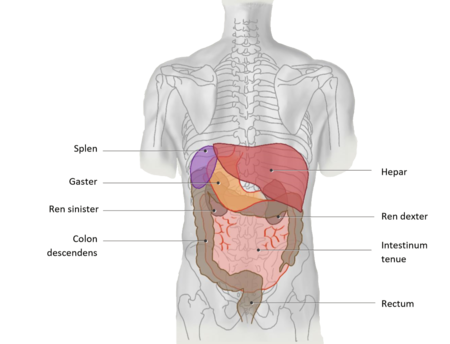Leber (Hepar)/en: Unterschied zwischen den Versionen
Becher (Diskussion | Beiträge) (Die Seite wurde neu angelegt: „==Liver segments==“) |
Becher (Diskussion | Beiträge) (Die Seite wurde neu angelegt: „<b>Assignment to Parts and Divisions</b> <table border="1" cellpadding="10">“) |
||
| Zeile 66: | Zeile 66: | ||
</div> | </div> | ||
| − | <b> | + | <b>Assignment to Parts and Divisions</b> |
<table border="1" cellpadding="10"> | <table border="1" cellpadding="10"> | ||
Version vom 3. Januar 2020, 13:14 Uhr
Inhaltsverzeichnis
Function of the liver
As the largest and most important metabolic organ, the liver has various tasks in the human body. It produces vital proteins and is significantly involved in the utilization of food components as well as the breakdown and excretion of substances.
Structure of the liver
<segmenter>https://dornheim.cloud/index.php/apps/segmenter/embedding/view?identifier=UfUm4eWaRri1</segmenter>
| View from dorsal to the superior pars of the Facies diaphragmatica | View from ventral to the Facies diaphragmatica | View from caudal to the Facies visceralis |
| Most of the liver surface is surrounded by visceral peritoneum. However, the Area nuda remains the only peritoneal free, its surface forming the connective tissue capsule. Outside of peritoneal coverage, the three Vv. hepatica usually leave the liver. A peculiarity is that in the liver only the supplying artery and supplying V. portae hepatis and Ductus choledochus run in the Mesohepaticum, whereas the laxative veins do not. At the transients from the visceral to the parietal peritoneum at the underside of the diaphragm, the connective tissue peritoneal epithelium appears as "strand" (Lig. coronarium). From this connective tissue structure a small tip develops on the left hepatic lobe (appendix fibrosa hepatis). |
From the ventral view, the two liver lobes, the large Lobus hepatis dexter and the smaller Lobus hepatis sinister, are clearly visible. The Lig. falciforme hepatis runs between the two lobes. The Ligamentum falciforme hepatis forms the Mesohepaticum ventrale and thus the connection between liver and abdominal wall. |
The caudal view allows a look at two more of the four liver lobes: the Lobus caudatus and the Lobus quadratus hepatis. The Lig. hepatoduodenale serves the liver together with the Lig. hepatogastricum as Mesohepaticum dorsale and belongs topographically to the Omentum minus. The gall bladder overhangs the lower edge of the liver with the fundus and lies close to the facies visceralis. The neck of the gall bladder points to the hepatic orifice, where it comes into contact with the extrahepatic bile ducts. |
Projection and Topography
Projection
The liver is located in the right upper abdomen, but extends beyond the epigastrium into the left upper abdomen. It pushes itself far in front of the stomach, which leaves a mark (Impressio gastrica) on the back of the left hepatic lobe. The right lobe of the liver comes into close contact with the colon (right flexure), the small intestine (Pars superior), the upper part of the right kidney and the right adrenal gland. Their impression sites are also named: Impressio colica, duodenalis, renalis and suprarenalis (see "WebViewer"). The position of the liver is strongly dependent on respiration, since its underside is fused with the diaphragm. Age and posture are also decisive for the position of the liver. The gall bladder lies dorsally between the left and right lobe of the liver.
Liver in situ
 The thin tissue area between the liver and the curvature of the stomach is called Omentum minus. This serous skin cloths the peritoneal cavity and is the ventral limit of bursa omentalis. This is bordered to the right by the liver.
The thin tissue area between the liver and the curvature of the stomach is called Omentum minus. This serous skin cloths the peritoneal cavity and is the ventral limit of bursa omentalis. This is bordered to the right by the liver.
The downward pointing edge of the liver is sharp-edged and easy to feel with an enlarged liver. The liver extends from the right regio hypochondriaca via the regio epigastrica to the left upper abdomen. The stomach is visible at the left lower edge of the liver. The gall bladder is located on the underside of the liver and towers above the lower edge of the liver.
Liver segments
<segmenter border="1">https://dornheim.cloud/index.php/apps/segmenter/embedding/view?identifier=OiSnWp028ERU</segmenter>
Assignment to Parts and Divisions
| Pars hepatis sinistra | |
| Segment I | Pars posterior hepatis, Lobus caudatus |
| Segmentum posterius laterale sinistrum (= Segmentum II) Segmentum anterius laterale sinistrum |
Divisio lateralis sinistra |
| Segmentum mediale sinistrum (= Segmentum IV) untergliedert in Segment IVa und IVb |
Divisio medialis sinistra |
| Pars hepatis dextra | |
| Segmentum anterius mediale dextrum (= Segmentum V) Segmentum posterius mediale dextrum |
Divisio medialis dextra |
| Segmentum anterius laterale dextrum (= Segmentum VI) Segmentum posterius laterale dextrum |
Divisio lateralis dextra |
weiterführende Links
